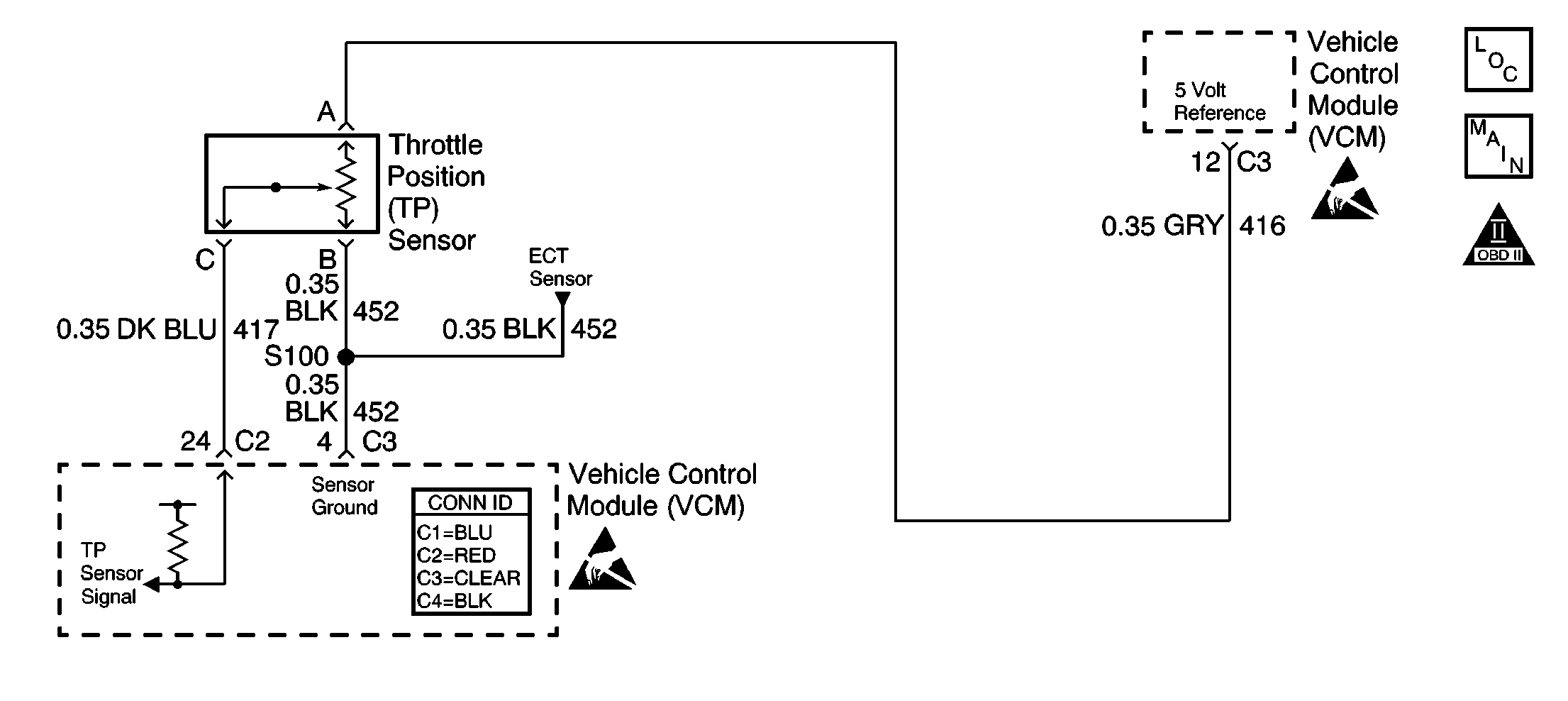
Circuit Description
The controls module monitors the engine coolant temperature (ECT) sensor and engine run time in order to determine how long it takes the ECT to reach the coolant temperature required for Closed Loop operation. DTC P0125 sets if the control module determines that the ECT does not reach a minimum coolant temperature required for Closed Loop operation in a specified amount of time.
Conditions for Running the DTC
| • | The engine is running. |
| • | No ECT sensor DTCs are active. |
| • | No IAT sensor DTCs are active. |
| • | The IAT is more than -40°C (-40°F). |
| • | The ECT is more than -40°C (-40°F). |
| • | The start-up ECT is less than 40°C (104°F). |
| • | For a vehicle with a start-up coolant temperature of -40°C (-40°F): |
| - | The accumulated air flow since start is more than 7,500 grams. |
| - | The accumulated idle time is less than 360 seconds. |
| • | For a vehicle with a start-up coolant temperature of -7°C (20°F): |
| - | The accumulated air flow since start is more than 4,500 grams. |
| - | The accumulated idle time is less than 225 seconds. |
| • | For a vehicle with a start-up coolant temperature of 10°C (50°F): |
| - | The accumulated air flow since start is more than 1,600 grams. |
| - | The accumulated idle time is less than 90 seconds. |
Conditions for Setting the DTC
The closed loop coolant temperature is not reached within a predetermined time. The maximum allowable time depends on the start-up coolant temperature and the amount of air flow into the engine.
- For a start-up coolant temperature of -40°C (-40°F):
- For a start up coolant temperature of -7°C (20°F):
- For a start up coolant temperature of 10°C (50°F):
The ECT is less than 20°C (68°F) after 8 minutes.
The ECT is less than 20°C (68°F) after 5 minutes.
The ECT is less than 20°C (68°F) after 2 minutes.
Action Taken When the DTC Sets
| • | The control module illuminates the malfunction indicator lamp (MIL) if a failure is detected during 2 consecutive key cycles. |
| • | The control module sets the DTC and records the operating conditions at the time the diagnostic failed. The failure information is stored in the scan tool Freeze Frame/Failure Records. |
Conditions for Clearing the MIL or DTC
| • | The control module turns OFF the MIL after 3 consecutive drive trips when the test has run and passed. |
| • | A history DTC will clear if no fault conditions have been detected for 40 warm-up cycles. A warm-up cycle occurs when the coolant temperature has risen 22°C (40°F) from the startup coolant temperature and the engine coolant reaches a temperature that is more than 70°C (158°F) during the same ignition cycle. |
| • | Use a scan tool in order to clear the DTCs. |
Diagnostic Aids
When DTC P0125 sets, an out-of-range ECT sensor or an engine thermostat that does not operate correctly is indicated.
Check for a faulty connection or a damaged harness.
Inspect the VCM harness connector for:
An intermittent may be caused by any of the following conditions:
| • | A poor connection |
| • | Rubbed through wire insulation |
| • | A broken wire inside the insulation |
Thoroughly inspect any circuitry that is suspected of causing the intermittent complaint. Refer to Testing for Intermittent Conditions and Poor Connections in Wiring Systems.
If a repair is necessary, refer to Wiring Repairs or Connector Repairs in Wiring Systems.
Test Description
The numbers below refer to the step numbers in the diagnostic table.
-
This test checks the engine warm-up rate. In the Conditions for Setting the DTC text, the technician should be able to reference the allowable engine run time relative to the cold start-up temperature of the vehicle.
-
This test checks the coolant sensor reading on the scan tool and the actual coolant temperature.
Step | Action | Values | Yes | No |
|---|---|---|---|---|
1 | Did you perform the Powertrain On-Board Diagnostic (OBD) System Check? | -- | ||
2 | Check the cooling system coolant level. Is the coolant level low? | -- | Go to Loss of Coolant in Engine Cooling | |
Operate the vehicle within the Conditions for Setting this DTC as specified in the Conditions for Setting the DTC text. Does the ECT value rise steadily to and beyond the specified value within the time and temperature specified in the Conditions for Running and Setting? | 20°C (68°F) | Go to Diagnostic Aids | ||
|
Caution: To avoid being burned, do not remove the radiator cap or surge tank cap while the engine is hot. The cooling system will release scalding fluid and steam under pressure if radiator cap or surge tank cap is removed while the engine and radiator are still hot.
Is the actual coolant temperature near the scan tool ECT temperature? | -- | Go to Thermostat Diagnosis in Engine Cooling | ||
5 | Replace the ECT sensor. Refer to Engine Coolant Temperature Sensor Replacement . Is the action complete? | -- | -- | |
6 |
Does the scan tool indicate that the diagnostic passed? | -- | ||
7 | Does the scan tool display any additional undiagnosed DTCs? | -- | Go to applicable DTC | System OK |
